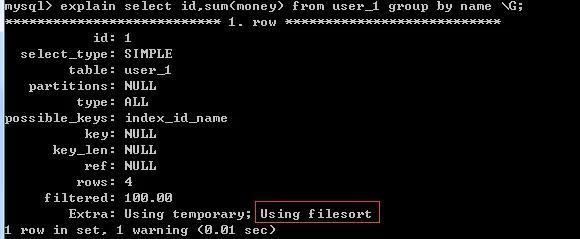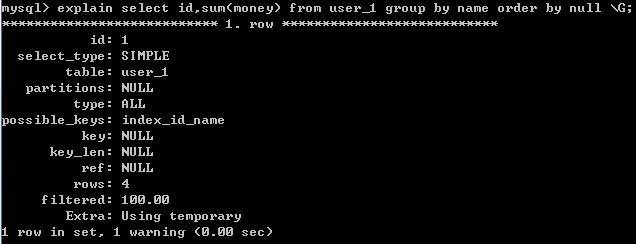开发中常用的MySQL优化技巧
来源:SegmentFault
时间:2023-01-21 20:32:27 451浏览 收藏
你在学习数据库相关的知识吗?本文《开发中常用的MySQL优化技巧》,主要介绍的内容就涉及到MySQL、数据库,如果你想提升自己的开发能力,就不要错过这篇文章,大家要知道编程理论基础和实战操作都是不可或缺的哦!
人生有六个字,前面三个是“不害怕”,后面还有三个是“不后悔”,不管怎样,努力去做吧。
1、大批量插入数据优化
(1)对于MyISAM存储引擎的表,可以使用:DISABLE KEYS 和 ENABLE KEYS 用来打开或者关闭 MyISAM 表非唯一索引的更新。
ALTERTABLE tbl_name DISABLEKEYS; loading the data ALTERTABLE tbl_name ENABLEKEYS;
(2)对于InnoDB引擎,有以下几种优化措施:
① 导入的数据按照主键的顺序保存:这是因为InnoDB引擎表示按照主键顺序保存的,如果能将插入的数据提前按照排序好自然能省去很多时间。
比如bulk_insert.txt文件是以表user主键的顺序存储的,导入的时间为15.23秒
mysql> load data infile 'mysql/bulk_insert.txt' into table user; Query OK, 126732 rows affected (15.23 sec) Records: 126732 Deleted: 0 Skipped: 0 Warnings: 0
没有按照主键排序的话,时间为:26.54秒
mysql> load data infile 'mysql/bulk_insert.txt' into table user; Query OK, 126732 rows affected (26.54 sec) Records: 126732 Deleted: 0 Skipped: 0 Warnings: 0
② 导入数据前执行SET UNIQUE_CHECKS=0,关闭唯一性校验,带导入之后再打开设置为1:校验会消耗时间,在数据量大的情况下需要考虑。
③ 导入前设置SET AUTOCOMMIT=0,关闭自动提交,导入后结束再设置为1:这是因为自动提交会消耗部分时间与资源,虽然消耗不是很大,但是在数据量大的情况下还是得考虑。
2、INSERT的优化
(1)尽量使用多个值表的 INSERT 语句,这种方式将大大缩减客户端与数据库之间的连接、关闭等消耗。(同一客户的情况下),即:
INSERTINTO tablename values(1,2),(1,3),(1,4)
实验:插入8条数据到user表中(使用navicat客户端工具)
insert into user values(1,'test',replace(uuid(),'-','')); insert into user values(2,'test',replace(uuid(),'-','')); insert into user values(3,'test',replace(uuid(),'-','')); insert into user values(4,'test',replace(uuid(),'-','')); insert into user values(5,'test',replace(uuid(),'-','')); insert into user values(6,'test',replace(uuid(),'-','')); insert into user values(7,'test',replace(uuid(),'-','')); insert into user values(8,'test',replace(uuid(),'-',''));
得到反馈:
[SQL] insert into user values(1,'test',replace(uuid(),'-','')); 受影响的行: 1 时间: 0.033s [SQL] insert into user values(2,'test',replace(uuid(),'-','')); 受影响的行: 1 时间: 0.034s [SQL] insert into user values(3,'test',replace(uuid(),'-','')); 受影响的行: 1 时间: 0.056s [SQL] insert into user values(4,'test',replace(uuid(),'-','')); 受影响的行: 1 时间: 0.008s [SQL] insert into user values(5,'test',replace(uuid(),'-','')); 受影响的行: 1 时间: 0.008s [SQL] insert into user values(6,'test',replace(uuid(),'-','')); 受影响的行: 1 时间: 0.024s [SQL] insert into user values(7,'test',replace(uuid(),'-','')); 受影响的行: 1 时间: 0.004s [SQL] insert into user values(8,'test',replace(uuid(),'-','')); 受影响的行: 1 时间: 0.004s
总共的时间为0.171秒,接下来使用多值表形式:
insert into user values (9,'test',replace(uuid(),'-','')), (10,'test',replace(uuid(),'-','')), (11,'test',replace(uuid(),'-','')), (12,'test',replace(uuid(),'-','')), (13,'test',replace(uuid(),'-','')), (14,'test',replace(uuid(),'-','')), (15,'test',replace(uuid(),'-','')), (16,'test',replace(uuid(),'-',''));
得到反馈:
[SQL] insert into user values (9,'test',replace(uuid(),'-','')), (10,'test',replace(uuid(),'-','')), (11,'test',replace(uuid(),'-','')), (12,'test',replace(uuid(),'-','')), (13,'test',replace(uuid(),'-','')), (14,'test',replace(uuid(),'-','')), (15,'test',replace(uuid(),'-','')), (16,'test',replace(uuid(),'-','')); 受影响的行: 8 时间: 0.038s
得到时间为0.038,这样一来可以很明显节约时间优化SQL
(2)如果在不同客户端插入很多行,可使用INSERT DELAYED语句得到更高的速度,DELLAYED含义是让INSERT语句马上执行,其实数据都被放在内存的队列中。并没有真正写入磁盘。LOW_PRIORITY刚好相反。
(3)将索引文件和数据文件分在不同的磁盘上存放(InnoDB引擎是在同一个表空间的)。
(4)如果批量插入,则可以增加bluk_insert_buffer_size变量值提供速度(只对MyISAM有用)
(5)当从一个文本文件装载一个表时,使用LOAD DATA INFILE,通常比INSERT语句快20倍。
3、GROUP BY的优化
在默认情况下,MySQL中的GROUP BY语句会对其后出现的字段进行默认排序(非主键情况),就好比我们使用ORDER BY col1,col2,col3…所以我们在后面跟上具有相同列(与GROUP BY后出现的col1,col2,col3…相同)ORDER BY子句并没有影响该SQL的实际执行性能。
那么就会有这样的情况出现,我们对查询到的结果是否已经排序不在乎时,可以使用ORDER BY NULL禁止排序达到优化目的。下面使用EXPLAIN命令分析SQL。Java知音公众号内回复“面试题聚合”,送你一份面试题宝典
在user_1中执行select id, sum(money) form user_1 group by name时,会默认排序(注意group by后的column是非index才会体现group by的排序,如果是primary key,那之前说过了InnoDB默认是按照主键index排好序的)
mysql> select*from user_1; +----+----------+-------+ | id | name | money | +----+----------+-------+ | 1 | Zhangsan | 32 | | 2 | Lisi | 65 | | 3 | Wangwu | 44 | | 4 | Lijian | 100 | +----+----------+-------+ 4 rows in set
不禁止排序,即不使用ORDER BY NULL时:有明显的Using filesort。

当使用ORDER BY NULL禁止排序后,Using filesort不存在

4、ORDER BY 的优化
MySQL可以使用一个索引来满足ORDER BY 子句的排序,而不需要额外的排序,但是需要满足以下几个条件:
(1)WHERE 条件和OREDR BY 使用相同的索引:即key_part1与key_part2是复合索引,where中使用复合索引中的key_part1
SELECT*FROM user WHERE key_part1=1 ORDER BY key_part1 DESC, key_part2 DESC;
(2)而且ORDER BY顺序和索引顺序相同:
SELECT*FROM user ORDER BY key_part1, key_part2;
(3)并且要么都是升序要么都是降序:
SELECT*FROM user ORDER BY key_part1 DESC, key_part2 DESC;
但以下几种情况则不使用索引:
(1)ORDER BY中混合ASC和DESC:
SELECT*FROM user ORDER BY key_part1 DESC, key_part2 ASC;
(2)查询行的关键字与ORDER BY所使用的不相同,即WHERE 后的字段与ORDER BY 后的字段是不一样的
SELECT*FROM user WHERE key2 = ‘xxx’ ORDER BY key1;
(3)ORDER BY对不同的关键字使用,即ORDER BY后的关键字不相同
SELECT*FROM user ORDER BY key1, key2;
5、OR的优化
当MySQL使用OR查询时,如果要利用索引的话,必须每个条件列都使独立索引,而不是复合索引(多列索引),才能保证使用到查询的时候使用到索引。
比如我们新建一张用户信息表user_info
mysql> select*from user_info; +---------+--------+----------+-----------+ | user_id | idcard | name | address | +---------+--------+----------+-----------+ |1 | 111111 | Zhangsan | Kunming | |2 |222222 | Lisi | Beijing | |3 |333333 | Wangwu | Shanghai | | 4 |444444 | Lijian | Guangzhou | +---------+--------+----------+-----------+ 4 rows in set
测试一:OR连接两个有单独索引的字段,整个SQL查询才会用到索引(index_merge),并且我们知道OR实际上是把每个结果最后UNION一起的。
mysql> explain select*from user_info where user_id=1or idcard='222222'; +----+-------------+-----------+------------+------------- |id|select_type| table |partitions| type | possible_keys | key |key_len| ref | rows | filtered | Extra | |1 | SIMPLE | user_info | NULL | index_merge|PRIMARY,ind_name_id,id_index | ind_name_id,PRIMARY | 4,62 | NULL | 2 | 100 | Using sort_union(ind_name_id,PRIMARY); Using where | 1 row in set
测试二:OR使用复合索引的字段name,与没有索引的address,整个SQL都是ALL全表扫描的
mysql> explain select*from user_info where name='Zhangsan' or address='Beijing';+----+-------------+-----------+------------+------+---------------+------+---------+------+------+----------+-------------| id | select_type | table | partitions | type | possible_keys | key | key_len | ref | rows | filtered | Extra |+----+-------------+-----------+------------+------+---------------+------+---------+------+------+----------+-------------| 1 | SIMPLE | user_info | NULL | ALL | NULL | NULL | NULL | NULL | 4 | 43.75 | Using where |+----+-------------+-----------+------------+------+---------------+------+---------+------+------+----------+-------------+1 row in set
交换OR位置并且使用另外的复合索引的列,也是ALL全表扫描:
mysql> explain select*from user_info where address='Beijing' or user_id=1;+----+-------------+-----------+------------+------+----------------------+------+---------+------+------+----------+-------------+| id | select_type | table | partitions | type | possible_keys | key | key_len | ref | rows | filtered | Extra |+----+-------------+-----------+------------+------+----------------------+------+---------+------+------+----------+-------------+| 1 | SIMPLE | user_info | NULL | ALL | ind_name_id,id_index | NULL | NULL | NULL | 4 | 43.75 | Using where |+----+-------------+-----------+------------+------+----------------------+------+---------+------+------+----------+-------------+1 row in set
6、优化嵌套查询
使用嵌套查询有时候可以使用更有效的JOIN连接代替,这是因为MySQL中不需要在内存中创建临时表完成SELECT子查询与主查询两部分查询工作。但是并不是所有的时候都成立,最好是在on关键字后面的列有索引的话,效果会更好!
比如在表major中major_id是有索引的:
select * from student u left join major m on u.major_id=m.major_id where m.major_id is null;
而通过嵌套查询时,在内存中创建临时表完成SELECT子查询与主查询两部分查询工作,会有一定的消耗
select * from student u where major_id not in (select major_id from major);
7、使用SQL提示
SQL提示(SQL HINT)是优化数据库的一个重要手段,就是往SQL语句中加入一些人为的提示来达到优化目的。下面是一些常用的SQL提示:
(1)USE INDEX:使用USE INDEX是希望MySQL去参考索引列表,就可以让MySQL不需要考虑其他可用索引,其实也就是possible_keys属性下参考的索引值
mysql> explain select* from user_info use index(id_index,ind_name_id) where user_id>0;+----+-------------+-----------+------------+------+----------------------+------+---------+------+------+----------+-------------+| id | select_type | table | partitions | type | possible_keys | key | key_len | ref | rows | filtered | Extra |+----+-------------+-----------+------------+------+----------------------+------+---------+------+------+----------+-------------+| 1 | SIMPLE | user_info | NULL | ALL | ind_name_id,id_index | NULL | NULL | NULL | 4 | 100 | Using where |+----+-------------+-----------+------------+------+----------------------+------+---------+------+------+----------+-------------+1 row in setmysql> explain select* from user_info use index(id_index) where user_id>0;+----+-------------+-----------+------------+------+---------------+------+---------+------+------+----------+-------------+| id | select_type | table | partitions | type | possible_keys | key | key_len | ref | rows | filtered | Extra |+----+-------------+-----------+------------+------+---------------+------+---------+------+------+----------+-------------+| 1 | SIMPLE | user_info | NULL | ALL | id_index | NULL | NULL | NULL | 4 | 100 | Using where |+----+-------------+-----------+------------+------+---------------+------+---------+------+------+----------+-------------+1 row in set
(2)IGNORE INDEX忽略索引
我们使用user_id判断,用不到其他索引时,可以忽略索引。即与USE INDEX相反,从possible_keys中减去不需要的索引,但是实际环境中很少使用。
mysql> explain select* from user_info ignore index(primary,ind_name_id,id_index) where user_id>0;+----+-------------+-----------+------------+------+---------------+------+---------+------+------+----------+-------------+| id | select_type | table | partitions | type | possible_keys | key | key_len | ref | rows | filtered | Extra |+----+-------------+-----------+------------+------+---------------+------+---------+------+------+----------+-------------+| 1 | SIMPLE | user_info | NULL | ALL | NULL | NULL | NULL | NULL | 4 | 33.33 | Using where |+----+-------------+-----------+------------+------+---------------+------+---------+------+------+----------+-------------+1 row in set
(3)FORCE INDEX强制索引
比如where user_id > 0,但是user_id在表中都是大于0的,自然就会进行ALL全表搜索,但是使用FORCE INDEX虽然执行效率不是最高(where user_id > 0条件决定的)但MySQL还是使用索引。
mysql> explain select* from user_info where user_id>0;+----+-------------+-----------+------------+------+----------------------+------+---------+------+------+----------+-------------+| id | select_type | table | partitions | type | possible_keys | key | key_len | ref | rows | filtered | Extra |+----+-------------+-----------+------------+------+----------------------+------+---------+------+------+----------+-------------+| 1 | SIMPLE | user_info | NULL | ALL | ind_name_id,id_index | NULL | NULL | NULL | 4 | 100 | Using where |+----+-------------+-----------+------------+------+----------------------+------+---------+------+------+----------+-------------+1 row in set
之后强制使用独立索引id_index(user_id):
mysql> explain select* from user_info force index(id_index) where user_id>0;+----+-------------+-----------+------------+-------+---------------+----------+---------+------+------+----------+-----------------------+| id | select_type | table | partitions | type | possible_keys | key | key_len | ref | rows | filtered | Extra |+----+-------------+-----------+------------+-------+---------------+----------+---------+------+------+----------+-----------------------+| 1 | SIMPLE | user_info | NULL | range | id_index | id_index | 4 | NULL | 4 | 100 | Using index condition |+----+-------------+-----------+------------+-------+---------------+----------+---------+------+------+----------+-----------------------+1 row in set
总结
(1)很多时候数据库的性能是由于不合适(是指效率不高,可能会导致锁表等)的SQL语句造成,本篇博文只是介绍简单的SQL优化
(2)其中有些优化在真正开发中是用不到的,但是一旦出问题性能下降的时候需要去一一分析。
文中关于mysql的知识介绍,希望对你的学习有所帮助!若是受益匪浅,那就动动鼠标收藏这篇《开发中常用的MySQL优化技巧》文章吧,也可关注golang学习网公众号了解相关技术文章。
-
499 收藏
-
244 收藏
-
235 收藏
-
157 收藏
-
101 收藏
-
233 收藏
-
385 收藏
-
412 收藏
-
320 收藏
-
432 收藏
-
108 收藏
-
315 收藏
-
358 收藏
-
113 收藏
-
128 收藏
-
460 收藏
-
349 收藏
-

- 前端进阶之JavaScript设计模式
- 设计模式是开发人员在软件开发过程中面临一般问题时的解决方案,代表了最佳的实践。本课程的主打内容包括JS常见设计模式以及具体应用场景,打造一站式知识长龙服务,适合有JS基础的同学学习。
- 立即学习 543次学习
-

- GO语言核心编程课程
- 本课程采用真实案例,全面具体可落地,从理论到实践,一步一步将GO核心编程技术、编程思想、底层实现融会贯通,使学习者贴近时代脉搏,做IT互联网时代的弄潮儿。
- 立即学习 516次学习
-

- 简单聊聊mysql8与网络通信
- 如有问题加微信:Le-studyg;在课程中,我们将首先介绍MySQL8的新特性,包括性能优化、安全增强、新数据类型等,帮助学生快速熟悉MySQL8的最新功能。接着,我们将深入解析MySQL的网络通信机制,包括协议、连接管理、数据传输等,让
- 立即学习 500次学习
-

- JavaScript正则表达式基础与实战
- 在任何一门编程语言中,正则表达式,都是一项重要的知识,它提供了高效的字符串匹配与捕获机制,可以极大的简化程序设计。
- 立即学习 487次学习
-

- 从零制作响应式网站—Grid布局
- 本系列教程将展示从零制作一个假想的网络科技公司官网,分为导航,轮播,关于我们,成功案例,服务流程,团队介绍,数据部分,公司动态,底部信息等内容区块。网站整体采用CSSGrid布局,支持响应式,有流畅过渡和展现动画。
- 立即学习 485次学习
